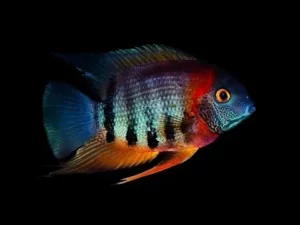
20 Common and Rare Neocaridina Shrimp Colors

Writer at The Aquarium Keeper
Neocaridina shrimp are very loved and adored in the fishkeeping hobby. These creatures are highly active, very peaceful, and fun to just simply watch. Neocaridina shrimp is a great start for beginner fishkeepers, because they do not require a lot, and can be kept in smaller aquariums.
Over the years there has been a big increase in different neocaridina shrimp colors. Breeders and various fishkeepers try housing different neocaridina shrimp, resulting in unique color patterns. Some of the neocaridina shrimp variants mentioned on this list are very common, others are super rare. Continue reading to find out all the unique neocaridina shrimp colors, that exist in the hobby right now!
Neocaridina Shrimp Species Overview
Before getting into neocaridina shrimp colors, first, it is important to overview the species itself, so if you would decide to buy shrimp, you would know how to properly care for them. We have already written a neocaridina shrimp care guide, so we will try to make a short summary in this article, of how to keep neocaridina shrimp the right way. All of the information mentioned below apply to all colors of neocaridina shrimp since they are the same species but just differ in color.
- Water Temperature: 15–30 °C (59–86 °F)
- pH: 6.5–8
- Water Hardness: 100—200 ppm
- Minimum Tank Size: 5 gallons
- Diet: Omnivorous (can eat blanched vegetables, algae, sinking pellets, blood worms, algae, and deceased fish)
- Tank Setup: Aquarium should have a filter, light, and heater installed
- Temperament: Very peaceful
- Tank Mates: shrimp tank mates can be small nano-fish (neon tetras, pygmy corydoras), that are peaceful, also other aquatic creatures like snails
- Decorations: driftwood, rocks, plant pots, aquatic plants
- Lifespan: 1-2 years
- Breeding: If female neocaridina shrimp is sexually mature, it can breed multiple times a year
- Size: up to 1.5 inches (4 cm)
- Care Level: Easy
Neocaridina shrimp don’t require much, but they are very fragile when it comes to environmental change, so be sure to create only the best conditions for these aquatic creatures. Some bigger fish can tolerate a sudden aquatic water parameter change, but neocaridina shrimp can become seriously ill and die, since they are very small, and don’t have strong immunity to changes.
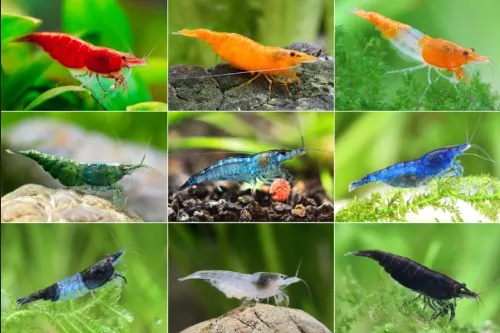
Selectively bred Assorted Shrimp Pack for purchase in the United States. Live arrival guaranteed!

Neocaridina Shrimp Colors
To begin our list, we would like to mention, that some of the colors chosen for this list are very common neocaridina shrimp variants, while others are just entering the hobby and it can be hard to find. All of the neocaridina shrimp colors mentioned here are real, and maybe will be available worldwide one day.
Wild Neocaridina Shrimp
Firstly, the most common shrimp color is considered wild type. From wild neocaridina shrimp, every other shrimp color was bred, which eventually led to a bunch of other different neocaridina color variants.
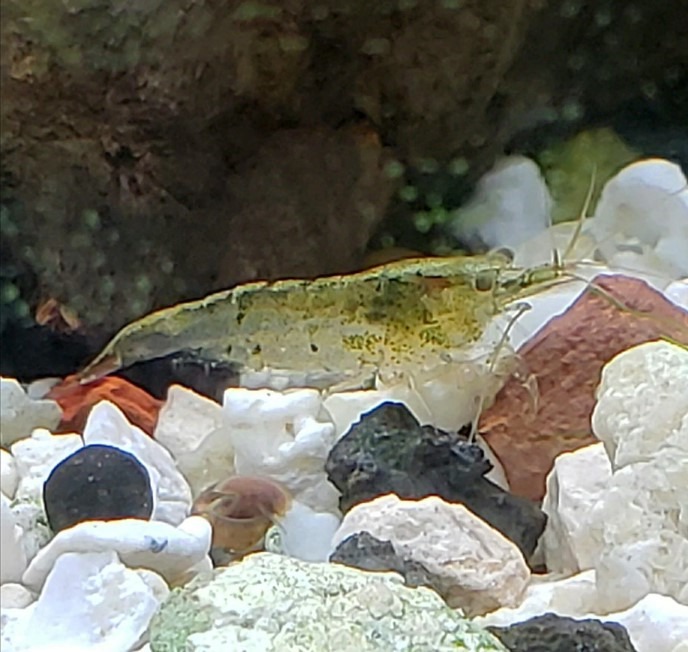
Wild-type shrimp are usually brownish, greenish, or blackish in color, or can even have red spots. These colors are needed in the wild, since shrimp are very small creatures, and need to blend into their surroundings. Here is the basic information about wild-type neocaridina shrimp:
- Scientific Name: Neocaridina palmata and neocaridina davidi
- Origin: China, Vietnam, Taiwan
- Rarity: Very common
- Price: 0.5$-2$ per shrimp
Wild neocaridina shrimp can also be called Neocaridina palmata or neocaridina davidi. These are actually two different neocaridina shrimp species, that can interbreed easily but have some biological differences. Neocaridina palmata shrimp were used to breed colors like blue pearl shrimp, while Neocaridina davidi is responsible for introducing popular colors into the hobby like red cherry shrimp, which is used to breed almost all other colors of shrimp.

Selectively bred Wild Shrimp for purchase in the United States. Live arrival guaranteed!

Snowball Shrimp
These neocaridina shrimp species are also called white pearl shrimp and are known for a distinctive white coloring, that really pops in darker aquarium setups. Even the eggs of snowball shrimp are white, which is why they have this creative name.

Snowball shrimp were bred from wild-type shrimp. It is a very long process to get to snowball shrimp because the most white wild-type shrimp had to be handpicked to create this color. Here is more information about snowball shrimp:
- Scientific Name: Neocaridina zhangjiajiensis var. “white”
- Origin: Germany
- Rarity: Rare
- Price: 5$-10$ per shrimp
What makes snowball neocaridina shrimp unique is even the “saddle” part of the shrimp is white. The saddle is a part on top of a female shrimp, just before she is about to mate.
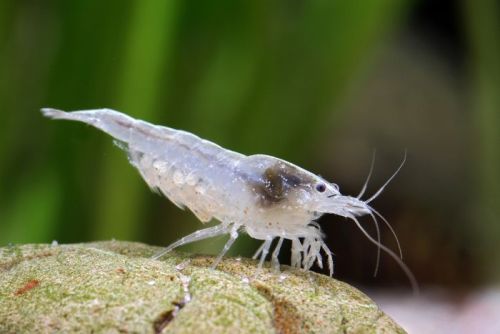
Selectively bred Snowball Shrimp for purchase in the United States. Live arrival guaranteed!

Yellow Sakura Shrimp
One of the most common neocaridina shrimp colors besides red is yellow sakura shrimp. These species can be graded (most colorful shrimp are called yellow sakura, while less colorful have different grading names).

Yellow sakura shrimp were bred from wild-type neocaridina davidi shrimp. To breed this distinctive and beautiful color, generations of neocaridina wild shrimp were handpicked, and only the most with yellow color were allowed to breed. Here is more information about this color neocaridina shrimp:
- Scientific name: Neocaridina davidi var. “Yellow”
- Origin: Taiwan
- Rarity: Common
- Price: 3$-7$ per shrimp
Some higher-grade yellow shrimp sometimes develop a golden stripe on their back. This can happen after molting, or when the shrimp reaches a certain age in life. This beautiful stripe is unique, and not every shrimp develops it.

Selectively bred Yellow Shrimp for purchase in the United States. Live arrival guaranteed!

Orange Pumpkin Shrimp
Pumpkin shrimp can also be graded like cherry shrimp or yellow sakura shrimp. Orange shrimp are very common in this hobby, but some shrimp keepers really enjoy this color, because it pops in darker aquarium setups.

Pumpkin shrimp were bred from red cherry shrimp. Constant particular shrimp selection through generations led to this amazing color. Here is more information about orange shrimp:
- Scientific name: Neocaridina davidi var. “Orange”
- Origin: Taiwan
- Rarity: Common
- Price: 3$-10$ per shrimp
This color shrimp is very closely related to yellow sakura shrimp and green jade shrimp, so throughout generations, there might be some different color shrimp popping up in your colony, of course, if you decide to keep orange pumpkin shrimp.

Selectively bred Orange Shrimp for purchase in the United States. Live arrival guaranteed!

Orange Rili Shrimp
These species are very similar to orange pumpkin shrimp, but just have a white gap in the middle of their body. They are rarer than orange shrimp, and females have yellow eggs, similar to any other neocaridina shrimp species.

Orange rili shrimp were bred directly from orange pumpkin shrimp, which makes them rare and more expensive. It takes a lot of time to breed orange rili shrimp, because not every generation of orange pumpkin shrimp will have this desired coloration.
- Scientific name: Neocaridina davidi var. “Orange Rili”
- Origin: Taiwan
- Rarity: Rare
- Price: 3$-10$ per shrimp

Selectively bred Orange Rili Shrimp for purchase in the United States. Live arrival guaranteed!

Green Jade Shrimp
Green jade neocaridina shrimp are also very popular in the hobby, but not as loved as other basic colors. Their color really blends in with the aquarium plants, which is why some fishkeepers choose different colors.

Green neocaridina shrimp can be bred from a few different strains. Some people breed them from yellow sakura shrimp, closely selecting all the offspring who have the greenest color, and making them breed more, while others get green jade shrimp from orange pumpkin shrimp, using the same methods.
- Scientific name: Neocaridina davidi var. “Green”
- Origin: Taiwan
- Rarity: Common
- Price: 3$-10$ per shrimp
These neocaridina shrimp color species also have a tendency to develop a yellow stripe on their back, similar to yellow sakura shrimp. Not all green jade shrimp do this, but the ones that develop the golden stripe just look phenomenal.
Emerald Shrimp
Similar to green jade shrimp, emerald neocaridina shrimp have a distinctive green color, although it is darker, and the whole shrimp itself does not have any transparent parts. Sometimes these species can even look slightly blue because their coloration widely depends on the surroundings they live in.
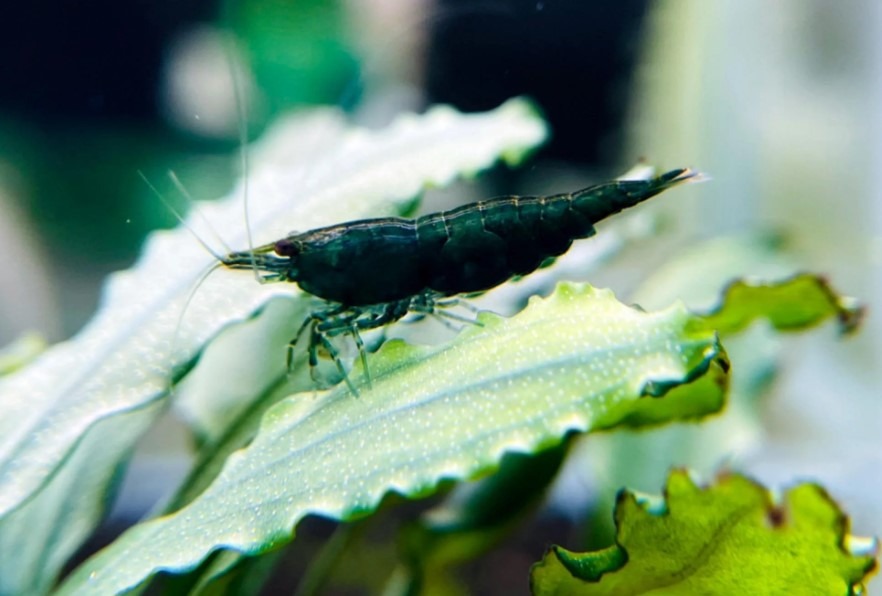
It is believed, that emerald shrimp were bred from green jade shrimp, but there might be more different options. Similar to all shrimp breeding, the best quality shrimp had to be selected to continue breeding, while less colorful shrimp were removed.
- Scientific name: Neocaridina davidi var. “Green”
- Origin: Taiwan
- Rarity: Rare
- Price: 5$-15$ per shrimp
Unlike green jade shrimp, emeralds very rarely develop a yellow stripe on their back. It is possible to have an emerald neocaridina shrimp with a yellow stripe, but it is rarer than green jade shrimp.
Green Rili Shrimp
Just like other rili neocaridina species, green rili shrimp have a white color part in the middle, while the tail and the head of the shrimp are green.

This coloration shrimp variant is one of the newest in the hobby and was probably bred from green jade shrimp. Here is more information about green rili shrimp:
- Scientific name: Neocaridina davidi var. “Green”
- Origin: Taiwan
- Rarity: Rare
- Price: 5$-15$ per shrimp
Mixing different colors with green rili shrimp would probably destroy the coloration in future baby shrimp, so you should try to keep only one coloration in a shrimp tank.
Red Cherry Shrimp
Apart from wild-type shrimp, red cherry neocaridina shrimp are the most colorful and popular type of shrimp, that can be found in almost any pet store. Almost all the different colorations came from breeding red cherry shrimp.

- Scientific name: Neocaridina davidi var. “Red”
- Origin: Taiwan
- Rarity: Very Common
- Price: 1$-2$ per shrimp
This type of shrimp rarely has the whole of the body covered in red color, it is usual when red cherry shrimp has a bunch of transparent spots. They are very cheap because they are considered to be one of the lowest grades of shrimp.

Selectively bred Red Cherry Shrimp for purchase in the United States. Live arrival guaranteed!

Sakura Red Shrimp
This shrimp coloration is bright red, and rarely has any transparent spots on the shrimp body. Similar to other shrimp types, sakura red shrimp can be graded, based on their color and looks. Most red ones are way more expensive, than basic red shrimp.

Sakura red shrimp are also very popular in the hobby and are available almost everywhere. Their price depends on the coloration, but since these species are very common, even the best-looking shrimp are not that expensive.
- Scientific name: Neocaridina davidi var. “Red”
- Origin: Taiwan
- Rarity: Common
- Price: 3$-10$ per shrimp
The females of red sakura shrimp sometimes develop a red stripe on the back, that goes across the body, this usually happens after molting. Since there is just a lot of red shrimp out there, this cool development is not very rare and is widely known in the hobby.

Selectively bred Red Sakura Shrimp for purchase in the United States. Live arrival guaranteed!

Kanoko Shrimp
Kanoko shrimp is probably the rarest coloration on this list since not a lot of people have these species. They are similar to red sakura shrimp but have dark spots on their body, and the red color is way darker.

These species were probably bred from the highest quality red sakura or bloody mary shrimps. Right now there are just simply not enough information regarding this coloration, and kanoko shrimp are not really available for buying yet.
- Scientific name: Neocaridina davidi var. “Red”
- Origin: Germany
- Rarity: Very Rare
- Price: Unknown
Another cool factor about kanoko shrimp is that the females carry black eggs when berried, instead of classic yellow eggs. These cool little details make kanoko shrimp extremely rare and expensive at the same time.
Red Rili Shrimp
Another rili species on this list is the red rili shrimp. They are well known in the shrimp community, and almost as common as the basic sakura red shrimp.

Red rili shrimp were bred from sakura red shrimp. Similar to other rili shrimp, red rili have white transparent coloration in the middle of their body, while the head and the tail are red.
- Scientific name: Neocaridina davidi var. “Rili”
- Origin: Taiwan
- Rarity: Common
- Price: 3$-7$ per shrimp
Another cool thing about red rili shrimp is their little legs. Some legs are white, and some are red, which makes these species very unique. Red rili shrimp are a relatively common species, which makes them cheap and available at a lot of pet stores.

Selectively bred Red Rili Shrimp for purchase in the United States. Live arrival guaranteed!

Blue Rili Shrimp
A more interesting rili shrimp is blue rili shrimp. These species have a distinctive blue coloration in the middle while having a dark red color on their tail and head.

These species are bred from basic red rili shrimp and are extremely rare. Blue rili shrimp is another new addition to the hobby, which makes them not really available to the mass public yet. Nevertheless, here is the known information about blue rili shrimp:
- Scientific name: Neocaridina davidi var. “Rili”
- Origin: Taiwan
- Rarity: Very Rare
- Price: Unknown
Because this coloration is very rare, it still shares the same scientific name as red rili shrimp. Breeding a new strain is very hard because you need to have multiple same-looking shrimp (different genders) to create a strain, and even sometimes that does not work out.
Blue Jelly Shrimp
Moving on, one of the most beautiful shrimp colorations is blue jelly shrimp. Unlike blue rili shrimp, these species are more available, because there are more strains of blue jelly shrimp created.

Blue jelly shrimp have a bright blue color to their body, while their eggs and saddle stay yellow. They were probably bred from blue rili or red rili shrimp.
- Scientific name: Neocaridina davidi “Blue Jelly”
- Origin: China
- Rarity: Rare
- Price: 5$-10$ per shrimp
The coloration of blue jelly shrimp is so unique, that their organs can even be seen. Blue jelly shrimp females are usually more colorful, while males can even sometimes look greenish or brownish.
Chocolate Shrimp
Another common neocaridina shrimp color is chocolate shrimp. This coloration does extremely well in lighter aquarium setups because the shrimp can be easily seen.
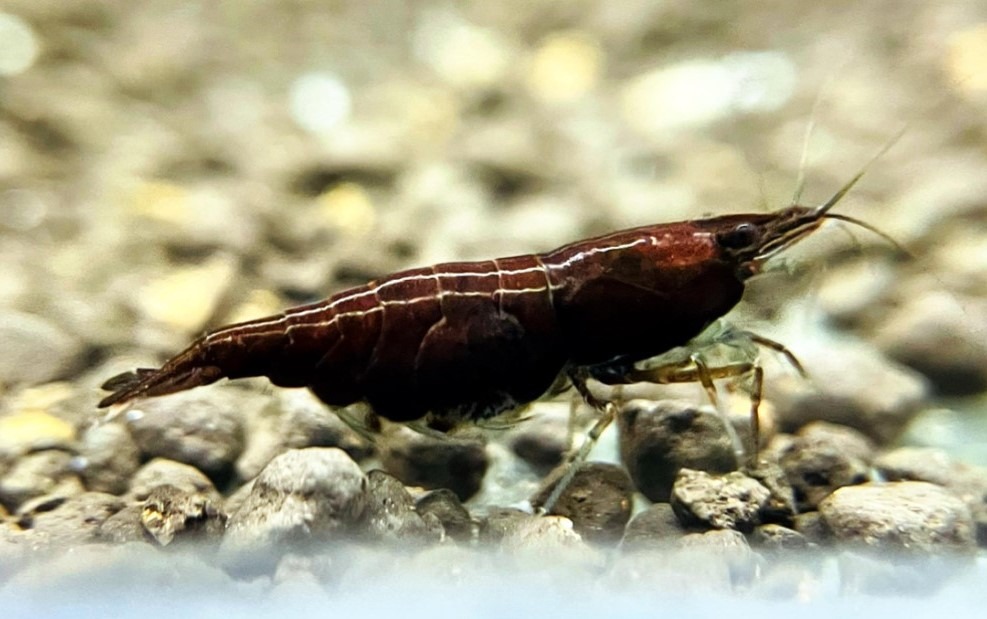
Chocolate shrimp were bred from wild-type shrimp. The darkest wild-type shrimp were chosen and bred. Over a bunch of shrimp generations, chocolate shrimp were introduced to the hobby, although they are very common at this point.
- Scientific name: Neocaridina davidi “Chocolate”
- Origin: Taiwan
- Rarity: Common
- Price: 3$-7$ per shrimp
Some female chocolate shrimp also tend to develop a light brown stripe on their back. Chocolate shrimp can also be graded, the darkest and purest shrimp are the most expensive.
Blue Dream Shrimp
If you liked the blue jelly shrimp, you will definitely enjoy looking at blue dream shrimp. Unlike blue jelly shrimp, this coloration species have a way darker blue hue, which is unique in its own way.

Blue dream shrimp were bred from chocolate shrimp, selecting the darkest shrimp and continuously breeding them over and over. If you enjoy darker shrimp, the blue dream shrimp is a good fit for you.
- Scientific name: Neocaridina davidi var. “Blue Dream”
- Origin: Taiwan
- Rarity: Common
- Price: 3$-7$ per shrimp
Similar to chocolate shrimp, blue dreams are really known in the hobby and are common. They can also be graded, but because of their availability, even the best-grade shrimp are affordable.

Selectively bred Blue Dream Shrimp for purchase in the United States. Live arrival guaranteed!

Black Rose Shrimp
An even darker coloration than chocolate is black rose shrimp. Keeping this coloration in darker setups would be a bad idea because simply you would not see your shrimp. Fish keepers prefer to keep black rose shrimp in lighter aquarium setups.

These species are rarer than chocolate shrimp, simply because black rose shrimp were bred from chocolate shrimp. Over the course of a lot of shrimp generations, black rose shrimp were bred by selecting the darkest chocolate shrimp and making them breed.
- Scientific name: Neocaridina davidi var. “Black Rose”
- Origin: Taiwan
- Rarity: Rare
- Price: 5$-15$ per shrimp
The best quality black rose shrimp can sometimes even appear to be shining because they do not have a single spot of transparency on them. Everything about this shrimp coloration is black, even the eggs.

Selectively bred Black Rose Shrimp for purchase in the United States. Live arrival guaranteed!

Carbon Rili Shrimp
Next is carbon rili shrimp. This is a very unique coloration because carbon rili has a transparent white coloration in the middle of its body while having a black head and tail. A lot of fish keepers love the amazing contrast, that carbon rili shrimp colors create.

Carbon rili shrimp were bred from dark rose shrimp. Occasionally a mutated shrimp appeared in black rose shrimp colonies, which were then bred into a different species, called carbon rili shrimp. They are slightly rare than black rose shrimp because they came from them.
- Scientific name: Neocaridina davidi var. “Carbon Rili”
- Origin: Taiwan
- Rarity: Rare
- Price: 5$-15$ per shrimp
Some carbon rilis can have even blue coloration to their transparent body part. Unlike black rose shrimp, carbon rili female shrimp usually have brown or yellow eggs when they are berried.
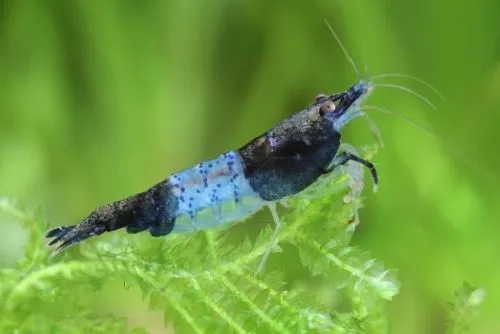
Selectively bred Carbon Rili Shrimp for purchase in the United States. Live arrival guaranteed!

Blue Carbon Rili Shrimp
Even more rare rili coloration is blue carbon rili shrimp. They are slightly different from carbon rili shrimp, usually having a blue transparent middle part instead of white.
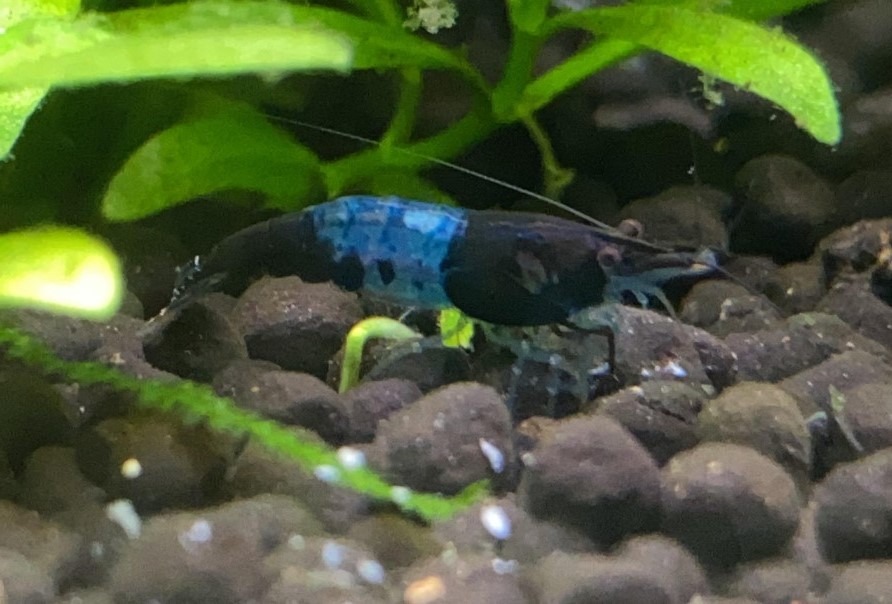
Blue carbon rili shrimp are relatively new, and there are not many of them in the fishkeeping world. They were probably bred from carbon rili shrimp or crossbred using black rose and blue dream shrimp. Either way, it is a very unique coloration, that every shrimp keeper would like to have.
- Scientific name: Neocaridina davidi var. “Blue Rili”
- Origin: Taiwan
- Rarity: Rare
- Price: 5$-15$ per shrimp
Usually, the females carry blueish-white eggs, which is very different and unique, compared to traditional neocaridina brown or yellow eggs.

Selectively bred Blue Rili Shrimp for purchase in the United States. Live arrival guaranteed!

Goldback Carbon Rili Shrimp
Another rare neocaridina shrimp coloration is the goldback carbon rili shrimp. These species are very similar to carbon rili shrimp, but just have a distinctive golden stripe, that goes from head to tail.

Unfortunately, this strain of neocaridina shrimp is extremely rare and is very new, which means it is not available for purchase yet. Right now there is not enough information on how goldback carbon rili shrimp are bred, but our guess is that some carbon rili shrimp develop this golden stripe on their head, and they can be separated to create a whole new strain of neocaridina shrimp.
- Scientific name: Neocaridina davidi var. “Carbon Rili”
- Origin: Taiwan
- Rarity: Very Rare
- Price: Unknown
Due to this special neocaridina color rarity, goldback carbon rili shrimp share the same scientific name as carbon rili shrimp. Maybe in the future, they will have their own name, but for now, goldback carbon rili shrimp are not that known.
Frequently Asked Questions
Can I Mix Neocaridina Shrimp Colors?
Almost all neocaridina shrimp like the same water parameters, so you can easily mix colors, but just know, that mixing different neocaridina variants can result in a bunch of wild-type offspring, that do not look as good as their parents.
Why is My Neocaridina Shrimp Losing Color?
Neocaridina shrimp tend to lose color if they are kept on a lighter substrate. Another reason might be is age. Shrimp usually change color throughout their life, and aging can be a reason for fading coloration.
Writer's Thoughts
I am a huge neocaridina shrimp fan, and it is very amazing, that occasionally new shrimp colorations get introduced into the hobby. Neocaridina shrimp are very easy to take care of, which is why I would recommend them to all beginner fishkeepers.
If you enjoyed reading our article, please feel free to share it with your friends by clicking the social media buttons below:

Thank you for reading my blog post. This website was created with the sole intention of providing quality information regarding fishkeeping. I have been in the fishkeeping hobby for 8 years, and through many trials and errors as well as online research I gathered a lot of information, which I want to give back to the community.




